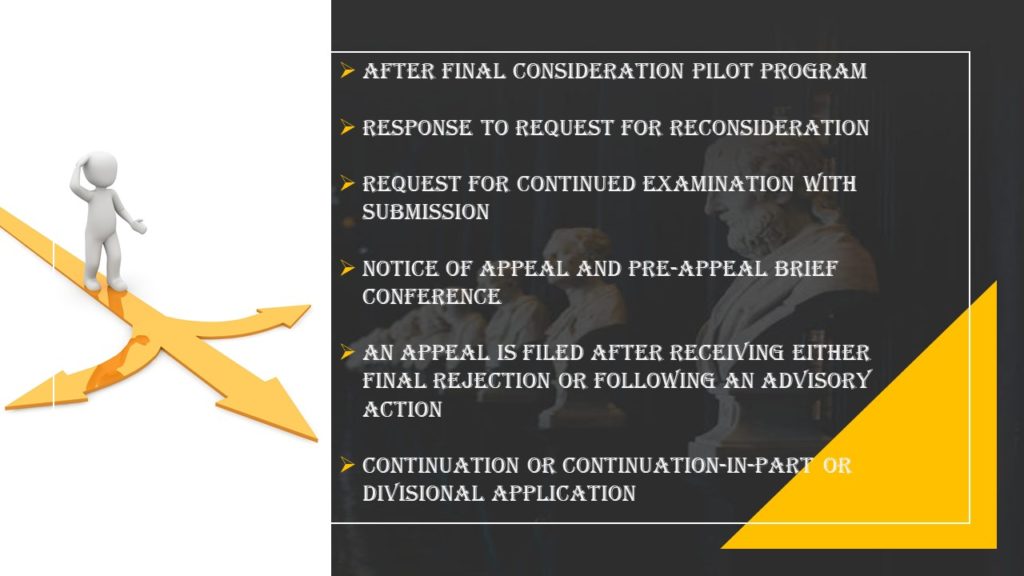A final office rejection is a fork in the prosecution pathway

A final office rejection is a fork in the road and not the end of the road during the patent prosecution pathway. Thus, don’t despair because you have several options with or without extra USPTO fees. Although the response after the final office action seems like a complex labyrinth, I will explain all options to you in detail.
You have a total of six months to do one or more of the steps described below before the application will become abandoned.
Final Office Action is the second or subsequent Examiner’s examination reply where the Examiner has rejected the same claims. After-final responses should be judiciously used and based upon the specific circumstances of a particular patent application. You should customize the response depending upon the Examiner’s reply, time after the response, and the patent application. The longer you wait, the USPTO’s fees increase, so the time is of the essence here. Importantly, you have a total of six months to do one or more of the steps described below before the application will become abandoned. There are seven options, as listed below.

Options in Detail
- After Final Consideration Pilot Program (AFCP) 2.0. There are no USPTO fees if filed within three months of the date of FOA. I recommend at least before the end of two months from the FOA date. AFCP has two essential requirements from you.
- You must amend at least one independent claim without broadening the scope of the claim.
- You must agree to an interview with the Examiner.
- Examiners can spend time to search, consider responses, and interview to discuss their search results with you. But the allowed time is less than replies to the first office action or RCE.
- You will benefit from the new search and consideration afforded by this program, even if you don’t get an allowance.
2. Response to Request for Reconsideration. You can submit a response to the Final Office Action and request the Examiner to reconsider.
- To be cost-effective, you must file an after-final response within two months of the Final Office Action date. Early filing of this response can either reduce or eliminate the USPTO fees of filing RCE in response to an Advisory Action.
- This response is the most appropriate pathway if there is an allowable subject matter. The response will take allowable claims and/or amend/cancel rejected claims to make them allowable. Thus response will place the application in a condition for allowance
- You do not have a right to broader claims for entry into the record.
- The Examiner has a right to either enter or not enter your response into the record. The entry of your response will depend upon the time required for further search of the prior art.
- You will get an Advisory Action from the Examiner if he does not consider your response.
- If you get an Advisory Action and you have made amendments in your response, you will need to file an RCE. Depending upon the elapsed time between filing RCE and the date of the Final Office Action, the RCE can be expensive.

3. Request for Continued Examination (RCE) with submission.
- You must amend one or more independent claims.
- RCE requires a USPTO fee, and the amount increases as the time between the FAO date and RCE filing date increases.
- You can file an RCE without paying for an extension provided the Advisory Action issued before the three months* extension-free deadline.
- To avoid paying higher extension fees, if your After-Final response gets rejected, it may be preferable to file the response with an RCE. The inclusion of the RCE is best if you’re beyond or even close to the three months from the Final Office Action date.
4. Notice of Appeal and Pre-Appeal Brief Conference. You can file a Pre-Appeal Brief Request for Review with the Notice of Appeal.
- Free of USPTO fees.
- You will file a five-page brief of the issues.
- You can not introduce new arguments in brief. Thus, the arguments must be already on record.
- A panel of three examiners will consider the brief. One of the three is the primary Examiner responsible for the application.
- The panel has three options:
- Send the application back to the Examiner for further prosecution.
- Allow it to continue in the appeal process.
- They can allow the application, which is a rare scenario.

5. An appeal is filed after receiving either a final rejection or following an Advisory Action.
- To start the appeal, file a Notice of Appeal.
- You will send the application for review by the USPTO’s Patent Trial & Appeal Board (PTAB).
- This process is time-consuming as most appealed applications wait in queue for two years or more before being considered by the PTAB.
- It is also more expensive compared to the other options and requires at least $2,800 in USPTO fees.
6. Continuation or Continuation-in-part or Divisional Application.
Continuation applications have the same disclosure as the parent application.
- The scope of the claims must not be identical to the parent patent, i.e., it can be broader or narrower compared to the parent patent.
- You can pursue canceled claims from the parent patent or new claims.
- It is best to consider the previous Examiner’s arguments and recite prior art references when drafting claims for a continuation application.
Divisional applications are applications consisting of the original claims that were not considered by the Examiner due to restriction requirements.
- It has the same disclosure and priority date as the parent application.
The invention improvements can be filed as a Continuation-in-part (CIP) application.
- CIP had contained parts of the parent and new disclosure that was not in the parent application.
- Claims based on the new disclosure will have priority of the CIP.
- Claims based solely on the parent application disclosure will be entitled to the priority date of the parent application.

7. Abandonment
- At any time within six months, you can abandon the application.
- You have six months from the Final Office Action date to complete one or more of the processes mentioned above. Otherwise, at the end of six months from the FOA date, the application will become automatically abandoned.

